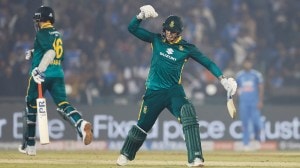The power of Gujarat’s godmen
I found myself on the same stage as Morari Bapu last week in Ahmadabad. There were others sharing the dais — Swami Madhavpriyads, the S...

I found myself on the same stage as Morari Bapu last week in Ahmadabad. There were others sharing the dais — Swami Madhavpriyads, the Sheikh of Broach, Justices Dharmadhikari and T.U. Mehta. The hall at the Management Institute was packed with teachers, lawyers, writers, businessmen, an equal mix of Hindus and Muslims, still trying to fathom the terrible things that happened in Gujarat two years ago and whether there was any danger of a flare up now that Lok Sabha elections are round the corner.
I mention Morari Bapu at the top of the list because he is a phenomenon in the state, not known outside. He is a Kathakar, a mesmeric one-man show, a wit, story teller, instant philosopher, reciter of bhajans, Urdu poetry, sometimes imperfect but rendered with aplomb, the entire performance dedicated to Lord Rama. There is a studied casualness about him. Seated near him, I could not but inhale a rich smell of incense which came either from something he carried in his pocket or fist, always covered by a shawl.
Since the meeting had been called by We The People, and four other NGOs busy in providing a healing touch to a much bruised state, Morari Bapu too addressed himself to the task of composing the cross community divide. But he could not help transforming his address into an abridged Rama Katha. The good news, however, is that Morari Bapu has offered his Vyaspeeth, or the travelling Rama Katha platform, as a forum to propagate communal peace.
Where does Morari Bapu derive his extraordinary clout from? From his popularity, of course. His Vyaspeeth draws crowds in lakhs — a five hundred thousand strong crowd is not unknown. This, in turn, tells us something about the people, including a vast section of the middle class. The mushrooming of godmen across the country is a phenomenon of our time. But the continuous hold they exercise on a population — almost as a substitute for other forms of entertainment — is unique to Gujarat. Time was when in neighbouring Maharshtra, for instance, theatre and natya sangeet held people enthralled. Names like Sawai Gandharva were legends. Indeed, the great singer Malikarjun Mansoor could only reach the middle rungs of natya sangeet.
In Gujarat, the austerities imposed by competitive Jainism, ritualised further by the Gandhians, kept people on the straight and narrow of religion. I remember when I was travelling around the country with Badshah Khan, the Frontier Gandhi, I was stopped from listening to cricket commentary at the Sevagram ashram. “Bapu only permitted news on the radio,” one of the ashram officials explained. Everything else was “pleasure” and thus taboo. I doubt if Gandhiji would have stopped me from listening to commentary. After all an ashtray was provided for Maulana Azad even though Gandhiji’s ashrams were no-smoking zones. But subsequent Gandhians strenuously transformed the simple life into one of rigorous austerity and ritual.
I am digressing. The point I am making is that the ground was always ready in Gujarat for religion as entertainment. Aesthetic pursuits like music and poetry were, possibly, considered excesses. It is probably symbolic that the grave in Ahmedabad that was razed to the ground was that of Wali Gujarati, a 17th century Urdu poet. Obviously, the people of Ahmedabad had over the decades been distanced even from such verses of Wali as: kooch a e yaar ain Kashi/hai/jogiya dil wahan ka baasi/hai (the lane where my beloved lives is as pure as the holy city of Kashi. The yogi of my heart has taken up residence there.) The patronage to the great singer Ustad Fayyaz Khan did not come from Gujarat but the princely house of Baroda. Little wonder his grave too was vandalised. The princely state was abolished decades ago and no one in today’s Vadodara can be expected to remember Fayyaz Khan’s: Mana Mohan Braj ke Rasia (Krishna of Braj, the winner of all hearts.) I seem to recall assaults on aesthetic symbols as part of a pattern in the Gujarat riots. In the 1969 riots, Rasoolan Bai’s house was burnt. A finer singer of Thumri and Dadra the country has not known.
Morari Bapu, and other lesser Kathakars perform a dual purpose possibly unintentionally. They fill up the asthetic void and, more important, they set Hinduism on the path of becoming a congregational religion — at least in the state. This process, in my view, began with the unprecedented success of TV serials on Ramayana and Mahabharata telecast 15 years ago. Streets were empty of traffic during the hours these serials were shown. The nation sat around TV sets as it would have before an altar. In Gujarat that ground has been consolidated by Morari Bapu.
At the moment this charismatic Kathakar, Morari Bapu is committed to healing wounds. This is wonderful news for all in Gujarat. In less tense times one may be tempted to engage in another discussion. If the aesthetic turf is so saturated with religiosity, will there be any room left for non-religious cultural activity? And is that a good thing?
- 01
- 02
- 03
- 04
- 05































